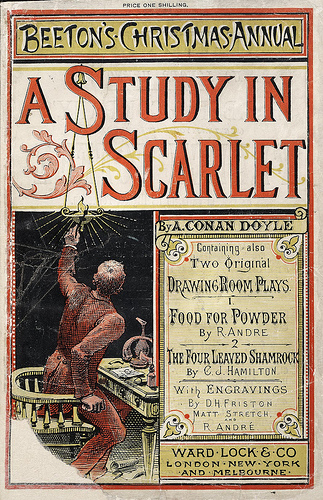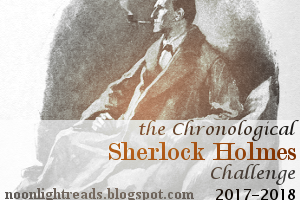

The Chronological Sherlock Holmes Challenge invites challenge participants to read all 60 Sherlock Holmes stories—four novels and 56 short stories—in the order in which they were published. The first Sherlock Holmes story published was the novel A Study in Scarlet, written in 1886 and published the following year in 1887. The novel introduces two of the most iconic characters in British literature—detective Sherlock Holmes and his friend and companion, Dr. John Watson.
In the event you are unfamiliar with the events of the novel, Dr. John Watson has returned from service in Afghanistan and looking for affordable lodgings when he happens upon an old friend who tells Watson that he knows someone else looking for lodgings, and if Watson doesn’t mind a few eccentricities, he might have himself a roommate. Watson consents to meet the gentlemen, who turns out to be Sherlock Holmes. The two agree to share lodgings at 221B Baker Street. Before Watson knows what is happening, he is involved in a case with Holmes. A body has been found in an abandoned house on Brixton Road, and the German word rache has been written over the body in blood—blood that does not belong to the victim. Watson follows Sherlock Holmes as he works with Scotland Yard inspectors Gregson and Lestrade. Sherlock Holmes unravels the mystery and determines the man, along with another victim found later in the story, was murdered in an act of revenge.
The first half of the novel involves Watson’s meeting with Holmes and Holmes’s subsequent involvement and deduction of the case, while the second half is a flashback taking place mostly in Utah, where the principles involved in the case—the two murdered men and their murderer—met and where the murderer developed the enmity that would drive him to chase the two men across two continents to kill them. In all honesty, the first half is charming, while the second half suffers (perhaps a bit comically) from Doyle’s lack of knowledge about America, Americans, the American West, and Mormons. It’s a fairly ridiculous story in some ways—rache, the German word for revenge, looks like a clue, but is really an afterthought of the killer’s (even though revenge was, in fact, his motive). I have to give the novel four stars for a great first half, but I can’t give it five after the mess of the second half.
Right after I finished reading the novel, I decided to watch the episode “A Study in Pink” of the BBC series Sherlock, starring Benedict Cumberbatch as Sherlock Holmes and Martin Freeman as John Watson, mainly because as I read A Study in Scarlet, it struck me that of all the iterations of I have seen of Sherlock Holmes stories, the current BBC series seems to capture Sherlock’s personality better than most—perhaps all—other adaptations. There is a quirky eccentricity that Benedict Cumberbatch’s Sherlock has that few other actors have managed to bring out in the same way. “A Study in Pink” pulls many elements from the plot of A Study in Scarlet, though thankfully not the second act set in Utah. It also does a masterful job of pulling the story forward to the 21st century while still adhering to many of the elements, including the identity of the murderer.
 As I work my way through the Chronological Sherlock Holmes Challenge, I plan to watch episodes of Sherlock that include elements of or allusions to the canon of 60 stories. I purchased a Kindle edition of the complete adventures, so I am not planning on counting the book as “completed” until I finish the entire collection, though I will track my progress reading the stories on my Reading Challenges page. The second story, also a novel, is The Sign of the Four. I will review each novel and short story here on the blog as I finish them.
As I work my way through the Chronological Sherlock Holmes Challenge, I plan to watch episodes of Sherlock that include elements of or allusions to the canon of 60 stories. I purchased a Kindle edition of the complete adventures, so I am not planning on counting the book as “completed” until I finish the entire collection, though I will track my progress reading the stories on my Reading Challenges page. The second story, also a novel, is The Sign of the Four. I will review each novel and short story here on the blog as I finish them.





Addendum: It looks like I misunderstood the challenge chronology. The stories follow perhaps a different chronology from their publication date, which is something I vaguely recall from reading them many years ago. I am going to try to catch up with the short stories for weeks one and two and post reviews here. Meanwhile, I’m a little ahead on the first novel, so probably no harm done.